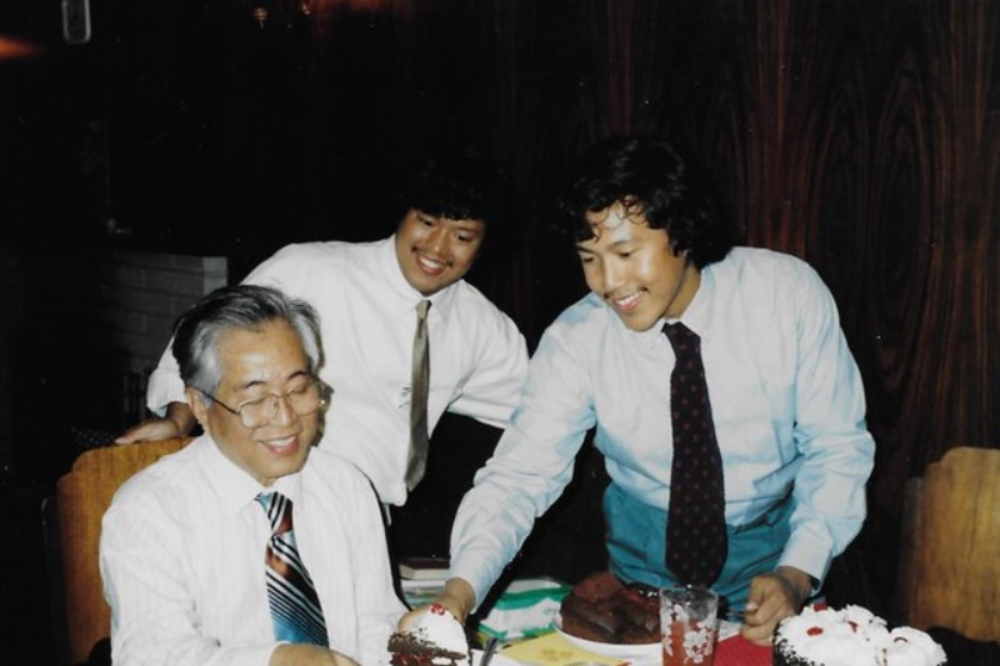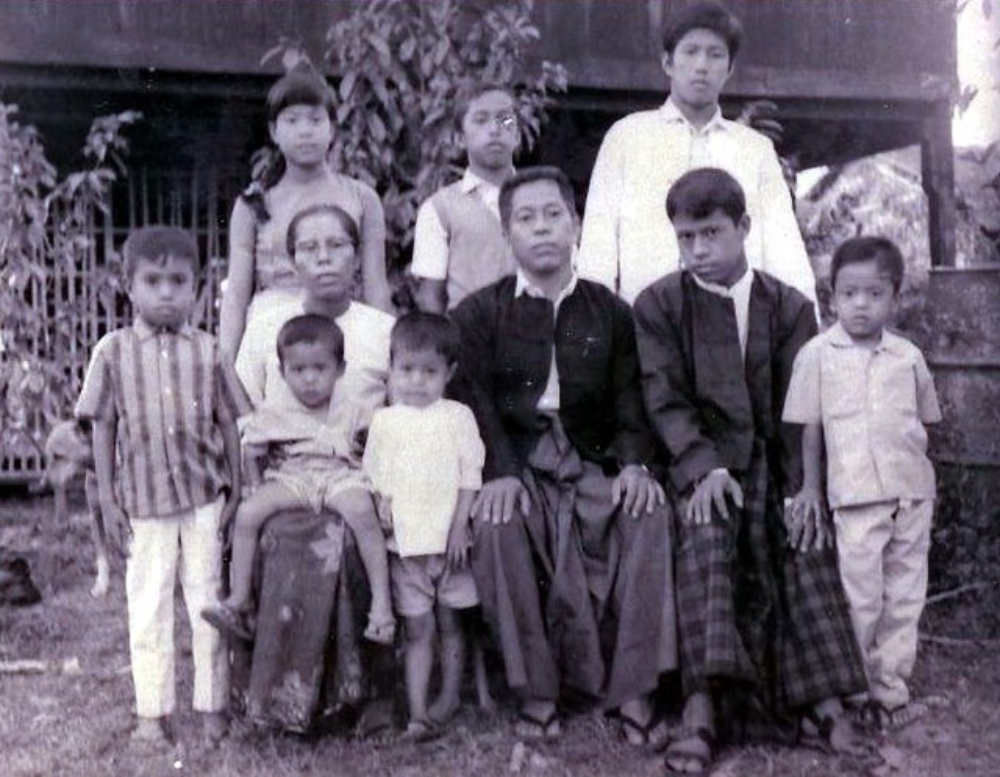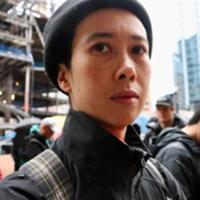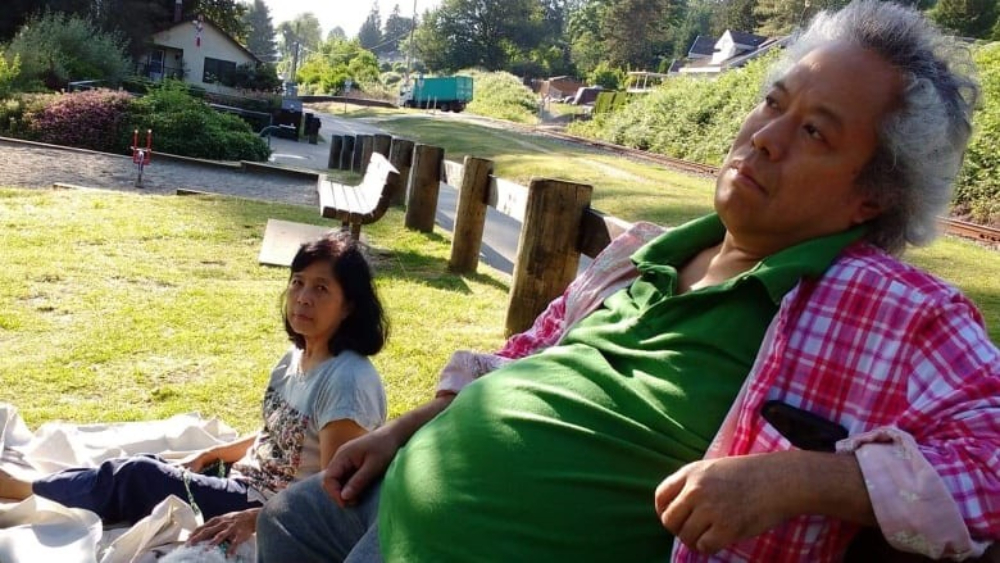On the afternoon of Aug. 11, 2019, four Ridge Meadows RCMP officers assembled outside the bedroom of Kyaw Din (his first name is pronounced “jaw”), a Burmese immigrant with schizophrenia. They had decided to apprehend him under B.C.’s Mental Health Act, a piece of legislation that gives police and health-care providers power to hospitalize and treat people for mental illness against their will.
Yin Yin Din had called 911 because she wanted police to help take Din, her brother, to the hospital. After he made a comment about her not looking like herself, she had reason to believe that he had stopped taking his medication.
At the coroners’ inquest into Din’s death earlier this month, the 911 call was played back to the jury (the deceased, who went by Kyaw Din when he was alive and is therefore named as such in this piece, is named Kyaw Naing Maung in provincial documents for the inquest).
The jury heard Yin Yin tell the dispatcher that Din had earlier said he wanted to hit her. She clarified that she was safe and interested only in police assistance getting him to the hospital. Yin Yin testified forcefully at the inquest that at no point was she ever fearful that her brother would hit her. He had never been violent before.
The first two RCMP officers on scene, Michael Wagner and Daniel Losiak, testified that they decided Din was apprehendable under the Mental Health Act based on information from the 911 call and his unwillingness to attend the hospital with them.
Because Din did not speak English, they relied entirely on Yin Yin to interpret for them. She relayed messages between the officers and Din through his closed bedroom door. Losiak admitted that de-escalating Din prior to entering the room was “a lot more difficult” because of the language barrier, elaborating that he did not know if Yin Yin was interpreting his messages to Din accurately, or vice versa.
He explained that he “strictly use[d]” Din’s “tone of voice” to form conclusions about Din’s mental state.
The jury learned that under 30 minutes after Wagner and Losiak arrived, Wagner called a corporal asking for a Taser-trained officer to assist in Din’s apprehension, citing a concern Yin Yin shared that if the police entered Din’s room, he might throw a bottle at them. Two officers, Benjamin Ouellette and supervisor Shayne Shea, arrived.
Yin Yin testified that she repeatedly asked the officers to wait for her elder siblings, who were on their way from Langley, to arrive so that they could speak with Din and convince him to go to hospital.
The officers did not wait. Those who were asked about that choice at the inquest said they did not believe waiting would have been beneficial, at the time or even in hindsight.
As to what happened once police entered Din’s bedroom, Ouellette testified that he deployed his Taser but it failed to paralyze Din. Wagner said he saw Din fall back after the Taser was deployed, pick up a small paring knife, and then try to cut Ouellette, at which point he fired his gun “until the threat was stopped.”
Din died after he was shot twice in the face and once in the chest.
Din’s family has always maintained that they do not believe he used a knife or attempted to attack the police. Yin Yin has described how Din looked when she last saw him, moments before his death, as “peacefully seated in the chair by his bed.”
At the conclusion of the inquest, Din’s siblings walked out of the Burnaby Coroners’ Court shaking their heads, their hopes for justice dashed.
The nearly all-white jury had spent half a day deliberating before releasing just three recommendations: to establish more case management contact with people with mental illness, provide or increase funding for first responders attending mental health incidents (which includes police) and establish a public school module about mental illness with the aim of de-stigmatizing it.
None of these recommendations reform existing police practices on mental health calls or toward civilians who don’t speak English.
In 2020, over a year after Din died, Ronald MacDonald, the chief civilian director of B.C.’s Independent Investigations Office, decided that the RCMP officers had acted lawfully and reasonably.
B.C.’s Independent Investigations Office investigates all police-related incidents resulting in death or serious harm in the province, including those involving off-duty officers.
Appalled by MacDonald’s decision, the Din siblings were hoping, against the ruling of the coroners’ inquest that attributed no fault or blame, that the jury would go against the grain and recommend that Crown Counsel charge the RCMP for their brother’s death.
Thant Din, Din’s older brother, described the recommendations as “weak” and said he had hoped that the jury would recommend that police stop attending mental health calls.
Each of the four cops who attended the call — Daniel Losiak, Matthew Wagner, Shayne Shea and Benjamin Ouellette — testified at the inquest that nothing could have been done better in their handling of the call. Shea, the supervising officer, could only say, when asked what could have been done differently by the Dins’ lawyer, that he wished “that the Taser had been effective.” Ouellette, who Tasered Din minutes after arriving on scene, told the jury, the presiding coroner and Din’s siblings that he had not thought about what could have been done differently since the event, had no regrets, and that nothing could have been done to spare Din’s life.
Wagner, who fired the fatal shots, said he couldn’t think of anything that could be done differently.

Constructing an ‘inevitable’ death
The jury appears to have agreed with the RCMP officers’ insistence that Din’s death was inevitable. Their decisions leave us with some important questions. What allowed the jury to treat Din’s death as a reasonable outcome of police decision-making? And if their recommendations won’t prevent police killings of people with mental illness, what could?
The Din family’s lawyer, Neil Chantler, gestured at the role race and culture played in Din’s death over the course of the inquest. Chantler focused on the officers’ lack of meaningful communication with Din, their dismissal of the benefit of family involvement in reasoning with Din, and their disinterest in overcoming the language barrier by calling an interpreter. These are all manifestations of systemic racism that unfolded beneath the umbrella of the Mental Health Act, a piece of legislation that gives police and psychiatric workers sweeping powers over people who have, or who are perceived to be experiencing, mental illness.
MacDonald’s report and the coroners’ inquest failed to acknowledge the power dynamic between Din and the police officers. The officers were white fluent English speakers. Din was a poor, racialized immigrant who did not speak English well enough to communicate with them.
But the only time racism was mentioned in the inquest was in a statement by Yin Yin, Din’s sister, that was ruled inadmissible.
According to the Independent Investigations Office website, out of 16 police-related deaths that the office has referred to Crown Counsel since it was founded in 2012, only two were referred by MacDonald, who took over in late 2017 (a third case may have been referred by MacDonald but there is no public information about when exactly it was referred). It is, statistically speaking, no surprise that MacDonald sided with the RCMP.
And where other institutions ostensibly tasked with police oversight fail, coroners’ inquests, even if they do produce decent recommendations, have no power to mandate government bodies to follow them. We cannot separate the supposed “inevitability” of Din’s death from the intersections Din himself occupied as a person who was poor, an immigrant, non-English-speaking, racialized and living with schizophrenia — exactly the kind of person that white, respectable, Canadian civil society sees as an outsider or doesn’t see at all.
But what stood out to me at the inquest, amidst the many factors that constructed Din’s death as a reasonable outcome of police intervention, is the way the Mental Health Act provides a fundamental legislative framework that provided the Independent Investigations Office, the RCMP, and ultimately the jury with an ideological framework to accept the police’s homicidal actions as reasonable and faultless.
Under the act, people can be apprehended by police, detained by doctors and forced to accept any treatment prescribed to them, in some cases, even after they are discharged from inpatient stays. Doctors can deploy warrants and have people arrested for failing to abide by their treatment protocols and are allowed to “discipline” patients.
A 2017 report on the act, “Operating in Darkness: BC’s Mental Health Act Detention System,” published by the Community Legal Assistance Society, notes that the use of physical restraints under the act is completely unregulated, that people can even have access to clothing removed as a disciplinary tactic, and concludes that “rights violations and procedural unfairness” under the act have “flourished in the absence of systemic oversight and evaluation.”
Section 28 of the Mental Health Act empowers police to apprehend someone if they are “apparently a person with a mental disorder” and are “acting in a manner likely to endanger” themselves or others.
Every officer involved repeatedly emphasized, in explaining the decisions they made that resulted in Din’s death, that Din was “apprehendable,” and therefore their duty was to apprehend him, often while employing stigmatizing views of schizophrenia and mental illness.
For example, when asked what he knew about schizophrenia, Ouellette began his response, “They can be unpredictable, [a] danger to self and others.” Wagner suggested that the police leaving Din’s home without apprehending him might have resulted in violence and created a “worse situation.”
MacDonald, who testified at the inquest, cited the act repeatedly in defending the officers’ behaviour. “Reasonable,” he said, is “based on what society at this point in time accepts as reasonable.” He explained that the Mental Health Act provided the “test of reasonableness” of the officers’ behaviours.
The problem with MacDonald’s logic is that there is no societal consensus over a reasonable way for cops to treat people with mental illness.
If anything, the inquest showcased two deeply antagonistic definitions of reasonableness: one forwarded by police and the other by Yin Yin and her brother Min, who was in the house when Din was killed and also testified.
In explaining the RCMP’s approach to use of force, expert witness and former Vancouver Police Department Sgt. Brad Fawcett characterized it as “officer-centred.” In order to understand the model, he explained, “you have to put yourself in the shoes of the officer.”
But Yin Yin and Min stayed firmly in Din’s shoes as they described his death as brutal and constituting murder. They did this even as Kuzma cut them each off repeatedly for assigning “fault” and “blame” through their choice of words.
Had the jury put themselves in Din’s shoes rather than the officers who killed him, they too might have arrived at a radically different test of reasonableness.

Involuntary admissions on the rise
On the day he died, Din’s sister Yin Yin called 911 because she wanted help taking her brother to the hospital. After the police arrived and Din said he did not want to go with them, she told the jury that she did not feel any urgency and thought it was acceptable to wait until her other siblings arrived. But by the time she began asking them to wait, the police had already decided that Din was apprehendable, setting into motion a process in which she was powerless to intervene.
The police’s decision to apprehend Din immediately disenfranchised him and his family from deciding what the best course of action would be for him — in this case, with fatal consequences. Had Din been certified under the Mental Health Act by a doctor at the hospital, he would have lost the ability to refuse any treatment prescribed to him, thanks to the “deemed consent” section of the act.
Under the Mental Health Act, the only resource available to people who are concerned about a loved one who may be unable to recognize that they are experiencing symptoms of mental illness is forced detention and treatment.
With the pandemic having coincided with an increase in mental health-related disabilities, marking a 2.3 per cent growth from 2019 to 2021, critically examining and reforming the state’s management of mental illness could not be more timely.
On the one hand, we know that involuntary psychiatric admissions are rising in B.C., to the point where the majority of mental health hospital admissions in this province are involuntary.
According to Health Justice, detentions under the act rose 71 per cent between 2005 and 2017, and in 2020 to 2021, 20,000 people were involuntarily admitted for psychiatric treatment, a number that had doubled over 14 years.
On the other hand, we know that police brutality disproportionately falls on people experiencing mental illness or who are using substances at the time of their death. McDonald testified at the inquest that 36 per cent of the Independent Investigations Office’s cases between 2020 and 2021 involved “persons in crisis.”
A well-known CBC study on police killings found that most victims of police death were experiencing mental health issues or substance use when they died, and noted that 2020 was a “particularly deadly year.”
In 2019, the BC Coroners Service Death Review Panel submitted a report for the chief coroner of B.C. called “Opportunities for Different Outcomes.”
The report, which focused on the four-year period between January 2013 and December 2017, found that seven out of 10 deaths by police or in the custody of a peace officer involved a mental health issue.
A recent Simon Fraser University study found that three in four prisoners in B.C. — 75 per cent — had a mental illness or substance use issues in 2017. That marked a rise of 15 percent since 2009.
These snapshots correspond to the two legs that the Mental Health Act stands on: psychiatric power and police power.
Because the act relies on a complementary, two-pronged approach in the management, control and suppression of the mentally ill, there are structural limitations to reforms that address it in isolated parts, rather than as a whole.
Fighting mental health stigma at its roots
Jonathan Morris, CEO of the Canadian Mental Health Association, testified that he wanted to see police relied on less as mental health responders, while also arguing that they are sometimes necessary. He cited the well-known CAHOOTS program in Eugene, Oregon, in which civilian teams are dispatched to mental health crises, as a successful approach.
While removing police as mental health first responders might make sense as an initial reform, it does not actually challenge police powers designated under the act. Fawcett testified to the challenge of replacing police with health-care workers. According to him, the VPD attempted to leave mental health calls to paramedics in 2017, but the trial only lasted one week because paramedics refused to attend calls until police were satisfied that they were “safe.” Having nurses attend with police or instead of police to mental health calls, at best, creates a buffer between civilians and armed cops that the act ensures is surmountable.
An ongoing, prominent initiative to change the act focuses on its psychiatric side. The Council of Canadians with Disabilities launched a charter challenge against the act’s empowerment of involuntary psychiatric treatment.
The province is fighting it tooth and nail — all the way to Canada’s Supreme Court — attempting to defend the act, adopted in 1964 and last substantially amended in 1998, from reform.
We should support such struggles with two goals in mind: advancing the rights of people with disabilities by challenging structures that disenfranchise them, and combatting a form of social control that dovetails with the policing and criminalization of mental illness.
Preventing future deaths
The inquest’s verdict falls short of any meaningful suggestions about how to prevent the deaths of people like Din, focusing on reforms that leave the act and policing practices untroubled.
At the very least, ending the empowerment of police apprehensions and psychiatric detainment under the act could have potentially saved Din’s life by removing the police’s main justification for refusing to respect Yin Yin’s expertise and request.
But overhauling the act to end coercive psychiatric and police powers is just a first step in the paradigm shift we need to create a public health-care system that centres the rights of people with mental illness, invests in prevention, provides culturally appropriate treatment to patients and replaces an overwhelming reliance on warrants, detainment and forced treatment with holistic responses that heal complex social, emotional and psychological forms of distress at their many roots.
A paradigm shift means challenging the biologically reductionist views of mental illness that go hand in hand with the common misperception that people with mental illness are dangerous.
Many studies have found that the narrative that mental illness is a biological condition like any other actually increases stigmatizing beliefs by encouraging what researchers call “genetic essentialism.”
Limiting our understandings of the causes of mental illness to individual causes like biology leaves out other contributing factors that could effectively be targeted through the use of public resources, like poverty.
Neither the Mental Health Act nor the prevailing view of mental illness as an individual, biological phenomenon can address the positive correlation between migration and schizophrenia.
Studies have found that recent immigrants to economically developed nations, particularly those who are negatively racialized, are disproportionately more likely to develop schizophrenia or psychosis. While most research has focused on Europe, Canadian studies have replicated these findings.
A 2015 study focusing on Ontario’s immigrant population found that refugee status was an independent predictor for psychotic disorders, and another Ontario study found that within the homeless population, which already has higher rates of schizophrenia, people born outside Canada had an even higher risk of developing schizophrenia or symptoms of psychosis.
After the jury’s recommendations were released, Yin Yin said, “They should have talked about systemic racism. I feel strongly [that] there is systemic racism in mental health care.”
What if Din got more from the health-care system than periodic hospitalizations and prescription medication? What if he was able to see a therapist with whom he could truly express himself, someone who could empathize with the pressures Din experienced as a Burmese immigrant and offer a space for him to make sense of his place in the world?
And what if Din’s schizophrenia was recognized, through the provincial health-care system, as not just an individual condition involving brain chemistry, but also an effect of complex social forces like racism, poverty, displacement and social marginalization?
The jury could have suggested overhauling the Mental Health Act to clear the way for substantial reforms around how the health-care system treats mental illness in poor, racialized communities — and that would have been just one way to address the deadly reliance on police response to mental illnesses as well as the inadequacies of that system, which is ultimately brought Din into contact with armed officers.
We cannot undo the tragedy of Din’s death. But by fighting to restructure the health-care system and its legislated dependence on various forms of state coercion, we can defend the lives of people living with mental illness from death and dehumanization. ![]()
Read more: Health, Rights + Justice, BC Politics

















Tyee Commenting Guidelines
Comments that violate guidelines risk being deleted, and violations may result in a temporary or permanent user ban. Maintain the spirit of good conversation to stay in the discussion.
*Please note The Tyee is not a forum for spreading misinformation about COVID-19, denying its existence or minimizing its risk to public health.
Do:
Do not: